Immagini
Viaggio cosmico di una nebulosa a forma di farfalla
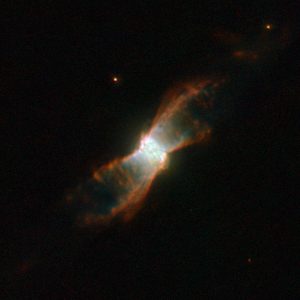
Il telescopio Hubble ha immortalato un’affascinante nebulosa planetaria, simile ad una delicata farfalla, denominata NGC 6881.
Situata nella costellazione del Cigno, è formata da una nube interna, che si estende per circa un quinto di anno luce, e da “ali” simmetriche che si espandono per circa un anno luce da un’estremità all’altra. La simmetria potrebbe essere dovuta ad una stella binaria nel centro della nebulosa. Continua a leggere
Vita e morte di una famiglia stellare

Questa suggestiva immagine dell’ESO riprende una famiglia di giovani stelle che si abbracciano su uno sfondo di nubi di gas incandescente e strisce di polvere. L’ammasso stellare, noto come NGC 3293, una decina di milioni di anni fa era soltanto una nube di gas e polveri, ma quando le stelle hanno cominciato a formarsi è diventato il gruppo brillante che possiamo ammirare. Continua a leggere
Una bolla celestiale
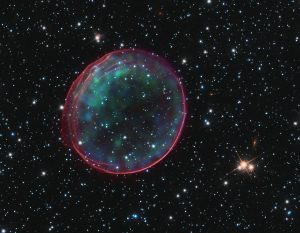
Questo guscio delicato, ripreso dal telescopio Hubble, sembra galleggiare serenamente nelle profondità dello spazio, ma questa calma apparente nasconde un tumulto interiore. Continua a leggere
Straordinario ritratto di una culla stellare

Un terra fantastica dipinta ad acquerello?
I colori nell’immagine possono sembrare distribuiti da sapienti pennellate, ma si tratta in realtà di una ripresa del centro della Nebulosa Cigno (Swan Nebula, M17), un focolaio di stelle neonate avvolte in coperte colorate di gas incandescente e cullate all’interno di un’enorme, fredda nube oscura.
Questa regione della nebulosa è circa 3500 volte più ampia di quella del nostro Sistema Solare. La nebulosa si trova a circa 5500 anni luce di distanza nella costellazione Continua a leggere
Arp 256
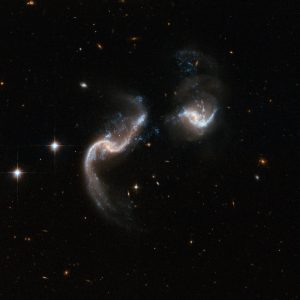
Arp 256 è un incredibile sistema di due galassie a spirale in una fase iniziale di fusione. L’immagine del telescopio Hubble mostra due galassie con forme fortemente perturbate e un numero impressionante di nodi blu di formazione stellare che appaiono come splendidi fuochi d’artificio.
La galassia a sinistra ha due estese code nastriformi di gas, polveri e stelle. Il sistema è luminoso all’infrarosso, irradiando più di cento miliardi di volte la luminosità del nostro Sole. Continua a leggere
Stelle titaniche in Pismis 24
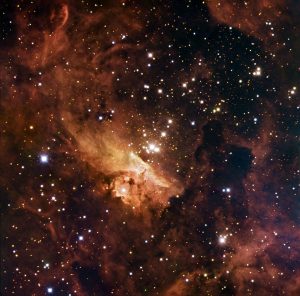
Sede di alcune delle stelle più grandi mai scoperte, l’ammasso stellare aperto Pismis 24 risplende dal cuore di NGC 6357, una nebulosa nella costellazione dello Scorpione. Diverse stelle hanno una massa di circa 100 volte quella solare, vere stelle titaniche.
Le strane formazioni presenti nelle nubi sono il risultato Continua a leggere
Luce stellare dall’oscurità

Il telescopio Hubble ha ripreso una suggestiva immagine di un sistema stellare multiplo chiamato XZ Tauri, della sua vicina HL Tauri, e di diversi giovani oggetti stellari. XZ Tauri soffia una calda bolla di gas nello spazio circostante, ricco di grumi brillanti che emettono forti venti e getti. Questi oggetti illuminano la regione, creando una scena spettacolare nell’oscurità dello spazio.
Il paesaggio celeste si trova a circa 450 anni luce di distanza nella costellazione del Toro, Continua a leggere
Caotica bellezza di stelle nascenti
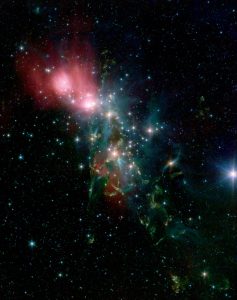
North is 14.5 deg CCW from up
Situata a circa 1.000 anni luce dalla Terra nella costellazione di Perseo, una nebulosa a riflessione chiamata NGC 1333 rappresenta l’incredibile, caotica bellezza di un denso gruppo di stelle nascenti.La maggior parte della luce visibile proveniente dalle giovani stelle in questa regione è oscurata dalla fitta, densa nube di polvere in cui si sono formate. Utilizzando il telescopio spaziale Spitzer della NASA gli scienziati possono rilevare la luce infrarossa da questi oggetti, che permette di osservare attraverso la polvere per ricavare una comprensione più dettagliata del modo in cui nascono le stelle. Continua a leggere
Un’affascinante galassia ricca di giovani stelle
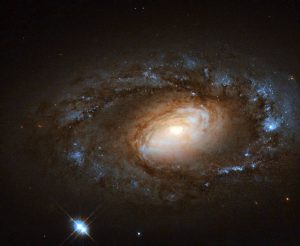
Il telescopio Hubble osserva alcune delle più belle galassie nei nostri cieli, spirali scintillanti di luminosi vivai stellari, coppie di galassie interagenti che si strappano a vicenda gas e stelle ed eteree galassie irregolari simili a stormi di uccelli sospesi nel buio dello spazio. Questa piccola spirale, conosciuta come NGC 4102, ha un tipo diverso di fascino, con i suoi bracci avvolgenti e il suo sobrio, ma affascinante aspetto. Continua a leggere
La fine di una stella
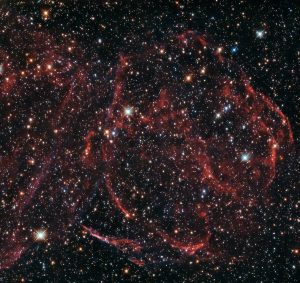
Questa immagine del telescopio Hubble immortala i resti di una stella morta da tempo. I filamenti ondulati di gas ionizzato, dal nome DEM L316A, si trovano a circa 160.000 anni luce di distanza, all’interno di una delle galassie più vicine alla Via Lattea, la Grande Nube di Magellano (Large Magellanic Cloud). Continua a leggere